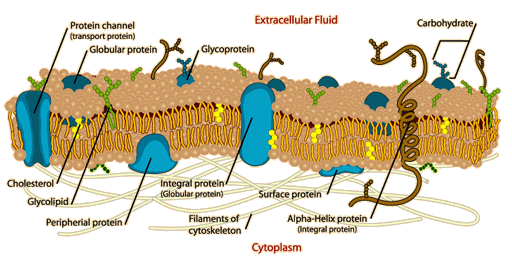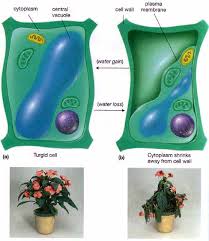Example 2
-Solution 0.4 M sugar
-Cell 1.0 M sugar
Water goes into the cell by osmosis
When will water movement stop (net) ?
1. when concentrations solutes are equal (Isotonic);
2. when cell would bursts;
3. when the cell fills enough to create a positive pressure that cancels out the force of Osmosis. (Pressure cancels Osmosis) - This is called Turgor Pressure
VI. The properties of the cell membrane ( The fluid mosaic model )
Composed of phospholipids, cholesterol (structural) and proteins (functional)
Functional Proteins:
A. Channels :- Aquaporins (dedicated of movement of water)
- Ion channels (devoted to Na+, Cl-, Ca2+, K+, etc.)
B. Carriers - Could be either active or passive. One molecule could be carried against the force of diffusion (ATP must be burned) or with the force of diffusion
C. Markers - Identify the cell as your own and also identify it as the type of cell
D. Pumps :
- Proton Pump - pumps H ions to 1 side of the membrane , creating a proton gradient that is used by ATP (synthase to make ATP)
- Sodium-Potassium Pump - uses ATP to pump Na+ out of the cell (neurons) and K+ ions back into the cell. Uses the energy from ATP to cause the protein to change its tertiary structure



No comments:
Post a Comment